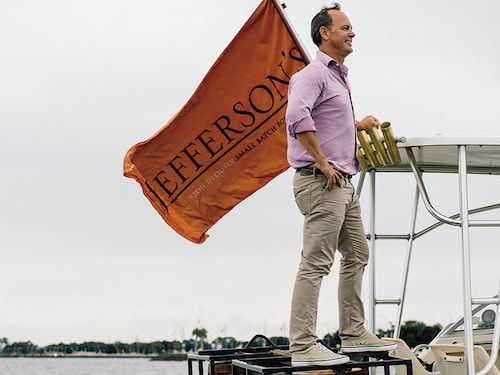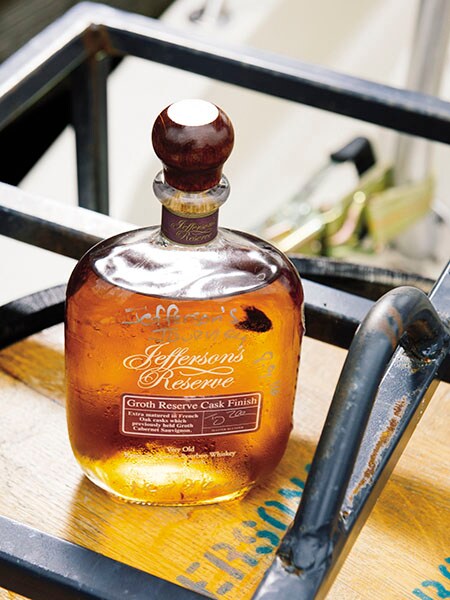The Marco Polo of Bourbon: How Jefferson's CEO Trey Zoeller ages whiskey in the
Jefferson's has journeyed into uncharted waters in whiskey-making by ageing small batches on the world's oceans, rivers and lakes


Emerging from the marshes to the north, a small motorboat cruises into New Orleans’ Lake Pontchartrain, travelling at a slow, steady 5 knots through the sticky August air. Steering the vessel is a one-person crew, a young man scruffily bearded after sleeping aboard for almost three months. Once across, the captain anchors along the palm-lined shore facing the city. The craft’s appearance—23 feet of ageing metal—belies the value of its cargo: Two 53-gallon oak barrels of bourbon. As well as the novelty of its journey from Louisville, Kentucky, down the Ohio River, then the Mississippi, to the Gulf of Mexico.
After the boat is in port a day or so, its owner, Trey Zoeller, a salt-and-pepper-haired Southerner, arrives to savour a special moment with its captain, Ted Gray. The barrels, secured on deck by steel cages, contain six-month-old whiskey. At that tender age, whiskey is normally as clear as water, tastes overly sweet and singes the palate. Instead, tapping the barrel with a power drill, Zoeller siphons out a liquid with the familiar chestnut colour of far older bourbon. After they raise glasses of it to their mouths, the captain finishes Zoeller’s next thought.
“There’s no&thinsp… ,” Zoeller says. “…&thinspbite at all,” Gray says.
Zoeller, 48, is the founder of Jefferson’s, a Louisville-based bourbon-maker named for America’s third president and founded in 1997. According to family lore, Zoeller came to whiskey-making naturally enough: He had a truly great grandmother who was a moonshiner in the late 18th century. She was “the first American woman arrested for illegal distilling,” he says proudly.
In this century, Jefferson’s continues to break the rules, excelling at the innovative flourishes that liquor companies need to come up with to survive competition. Fine bourbon is well-aged bourbon, and on a whim Zoeller began experimenting with ageing by stashing barrels (he also prefers Cabernet casks from Napa Valley’s well-regarded Groth Vineyard) in duck blinds to expose them to changing weather. His bourbon boats are another iteration of that philosophy.
As with many great ideas in the spirits industry, the concept of ageing whiskey on water emerged after several rounds of drinks. It came during a 40th birthday celebration on a yacht owned by a shark-researcher friend, Chris Fischer, off Costa Rica. As the ship swayed, Zoeller watched whiskey slosh around in glasses, and he imagined barreled whiskey doing the same. In theory, a boat’s rocking would speed up the ageing as the bourbon came into repeated contact with the barrel—and the elements. (Any high temperatures encountered would have a similar super-ageing effect.) In the end, this method would greatly reduce the wait. And with the bourbon exposed to nature’s unpredictability and transported along different routes, Zoeller would have a steady source of new expressions.
At first, Fischer was sceptical of the idea of carrying so much flammable liquid onboard. “But the more he drank,” Zoeller recalls, “the better the idea sounded to him”.
Jefferson’s Ocean debuted in 2012 after a journey of more than 10,000 nautical miles. Zoeller priced the 300 bottles at $200 and says they were soon reselling for ten times that. He plans to release the ninth Jefferson’s Ocean later this year.
Sea air gives Jefferson’s Ocean an unmistakable, salted caramel finish. Zoeller wanted to develop a less saline version while sticking with nautical maturation, so why not float it from Louisville to New Orleans—the way America’s first distilleries shipped bourbon in the 19th century?
A friend introduced him to Gray, 27, a former Eagle Scout with a passion for roughing it. “I looked down into this cabin,” Gray says, opening a hatch to a windowless 6-foot-long, 2-foot-high berth, “and thought, Oh, it’ll just be like sleeping in a tent for three months.”
Zoeller selected a small vessel for the voyage. A bigger one would ride steadier on the water, reducing the bourbon’s movement in the barrels.
After setting off in June down the Ohio River, Gray could smell the heat caramelising the bourbon, and sometimes it attracted swarms of honeybees. The journey had a few other moments of adventure. “We almost capsized three times,” Gray says, and while seeking shelter from one squall near Henderson, Kentucky, “I didn’t know if the dock was going to make it.”
With the boat safely harboured in New Orleans, Gray confidently proclaims his cargo “the world’s rarest bourbon”. While it has already aged remarkably well and quickly, it still has two more legs of its journey to go.
Zoeller plans to sail it himself on the much-shorter trip from New Orleans to Florida, accompanied by his friend John Besh, the New Orleans restaurateur and chef. Next, he’ll ar-range for it to sail to New York (with Gray possibly returning as captain).
The bourbon will be released in time for Christmas as Jefferson’s Journey, and Zoeller has yet to set a price. If Jefferson’s has a second journey like this, his captain has a list of improvements. “We could use a first mate,” Gray says, leaning on the boat’s wheel. “And air-conditioning.”
Zoeller nods along. “Yeah, and maybe we’ll get a bigger boat.”
First Published: Nov 09, 2016, 06:41
Subscribe Now